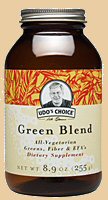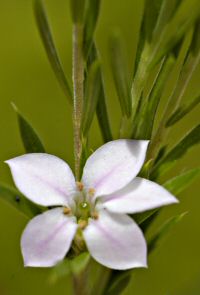|
|

 Greens
are our most important foods because they provide us with
all of the essential components of health. They
are our foods, as well as our medicines. Almost
every health problem will benefit from the use of green foods. Fresh
organic greens are best, because they are rich in essential nutrients.
"Where green plants cannot grow, we cannot live."
DOWNLOAD
THE PDF FILE ON UDO'S CHOICE™ BEYOND GREENS! (457k)
We refer to 'greens' as the diverse population of salt and fresh
water plants (algae), land plants, and land plants that have
returned to aquatic environments, all of which are green in color. 'Greens'
are the basic foundation of human health and regeneration and
have been an endless food source for living creatures as far
back as it goes.

Biologists believe that
land plants evolved from one-celled aquatic organisms and did
not
colonize the land until about ½ a billion years ago. Plants and
their green ancestors are rich in magnesium-containing chlorophyll,
the green pigment found in chloroplasts of plants. Chlorophyll
is what absorbs the light energy from the sun that drives photosynthesis,
making Earth the green planet.
'Greens'
dominate nearly all terrestrial communities. They are found in
gardens and woods; fields and meadows; on mountains; in valleys
and oceans; on our windowsill (sprouted from seeds); or in a
pot in the house. They include grasses, leaves, herbs, algaes,
seaweeds, broad-leafed plants, trees, mosses, lichens, ferns,
shrubs, weeds, and many more.

In
the Greek language, the word "phyto" means plant. Phytochemicals
are, by definition, any biologically active compounds derived
from plants. They function as the plant's immune system, defending
against exposure to diseases and viruses. They determine
plant color and taste and aid the many biological tasks plant
organisms
must carry out to survive.
Thousands of phytochemicals are found in plants, and
humans have only recently begun to study the molecular structure of these valuable
food compounds. Examples
of phytochemicals are carotenoids, flavonoids, plant sterols, polyphenols,
lignans, sulfides, curcumins, saponins, coumarins, terpenoids, phthalides,
and many more.
On-going research continues to provide new insights into what they are and
how they aid in the preservation of human health.
are
plant chemicals used as foods. Phytomedicines elicit biological
responses in the body systems of mammals that consistently reduce
the risk of one or more diseases of chronic nature. Phytochemical-rich
'greens' and other plant parts have been used, since as long
as man has been alive, to improve the health of those who consume
them.
They
are our foods, as well as our medicines. Where green
plants cannot grow, we cannot live.

Greens perform the following humble services ...
- Have been making the oxygen we
need to breathe for about 3 billion years (blue-green algae
were the first photosynthesizers);
- Provide us with water and
hold water in the soil;
- Dissolve and then absorb
the minerals from rocks and make them useable for us;
- Manufacture the vitamins that
are essential to our life;
- Manufacture amino acids
and proteins, as well as essential fatty acids and fats;
- Make sugars and starches,
which are fuel for our cells;
- Provide fiber and,
if raw, provide digestive enzymes as well as probiotics;
- Are our greatest source
of antioxidants;
- Provide phytonutrients,
nature's medicines;
- Alkalinize our
body into a healthier state; and
- Produce our steaks (a
cow is made from grass)!
Natural products made from plants are inexpensive and safe
(largely without adverse side effects), compared to conventional,
synthetic medicines. Dried greens keep well; can be carried in a
suitcase, briefcase, backpack, or purse; and, while not quite as
good as fresh greens, still contain most of the nutrients we need.
Some of the dry greens used in portable products include the sprouts
of grains, one-celled organisms, and dried vegetable powders. All
of these greens have virtues. We work with a product called Udo's
Choice Beyond Greens
 Almost every health problem will benefit from the use of green foods. Fresh
organic greens are best, because they are rich in essential
nutrients. Organic greens can be juiced or blended for easier
digestion; steamed or boiled; or dried for long term storage,
which is especially important for busy and/or travelling people.
Beyond
Greens provides:

- 50 super foods, food
concentrates, and plant extracts;
- A rich blend of greens from 9 different sources: organic alfalfa, barley, rye, and
oat grass powders; spirulina; chlorella; broccoli; parsley;
and kale;
- Omega-3 and omega-6 essential
fats (see oil blend product page for more details) from organic
flax, sunflower, and sesame seeds, as well as pumpkin seed,
and rice and oat germ;
- Protein from seeds and
greens;
- Both kinds of fiber;
especially rich in water-soluble mucilage;
- Phytonutrients and antioxidants from many herbs to support the functions of inner organs: immune
system, cardiovascular system, digestive system, liver, kidneys,
and pancreas;
- Concentrates of the
best vegetables: carrot, tomato, beet, kale, and others;
- Low carbohydrates and
therefore good for weight loss and glucose stability;
- A completely vegetarian
meal;
- A food free of dairy,
wheat, yeast, and other common allergens; and
- Taste enhanced greens with natural flavors.
- Murray, Michael, and
Pizzorno, Josheph, Encyclopedia of Natural Medicine. Prima
Publishing, 1998.
- Jensen, Bernard, The
Chemistry of Man. Bernard Jensen Publisher, 1983.
- Murray, Michael T, Encyclopedia
of Nutritional Supplements. Prima Publishing 1996.
- Weiss, Rudolf Fritz,
Herbal Medicine. Beaconsfield Publishers Ltd., 1998.
- Campbell, Neil A., Biology,
Fourth Edition. The Benjamin/Cummings Publishing Company, Inc.,
1996.
- Willard, Terry, Textbook
of Modern Herbology. Progressive Publishing Inc., 1988.
- Vanderhaeghe, Lorna,
The Immune System Cure. Kensington Publishing Corp., New York,
1999.
- Gursche, Siegfried,
Encyclopedia of Natural Healing. Alive Books, Burnaby, B.C.,
Canada, 1997.
- Rauma AL, et al., Antioxidant
status in long-term adherents to a strict uncooked vegan diet. Am
J Clin Nutr 1995 Dec;62(6):1221-7. Department of Clinical
Nutrition, University of Kuopio, Finland.
- Craig W.J., Health-promoting
properties of common herbs. Am J Clin Nutr 1999 Sept;70(3
Suppl):491S-499S. Department of Nutrition, Andrews University,
Berrien Springs, MI 49104-1210, USA.
- Kay Ra., Microalgae
as food and supplement. Crit Rev Food Sci Nutr 1991;30(6):555-73.
Cell Tech, Klamath Falls, Oregon.
- Beecher G.R., Nutrient
content of tomatoes and tomato products. Proc Soc Exp Biol
Med 1998 Jun;218(2):98-100. Food Composition Laboratory,
Beltsville Human Nutrition Research Center, ARS, USDA, Maryland
20705, USA.
- Sinatra S.T., DeMarco
J., Free radicals, oxidative stress, oxidized low density lipoprotein
(LDL), and the heart: antioxidants and other strategies to
limit cardiovascular damage. Conn Med 1995 Oct;59(10):579-88.
Manchester Memorial Hospital, USA.
- Bland J.S., Phytonutrition,
phytotherapy, and phytopharmacology. Altern Ther Health
Med 1996 Nov;2(6):73-6. HealthComm International Inc, Gig
Harbor, Wash., USA.
- Kurzer M.S., Xu X.,
Dietary phytoestrogens. Annu Rev Nutr 1997;17:353-81.
Department of Food Science and Nutrition, University of Minnesota,
St. Paul 55108, USA.
- Joshipura K.J., et al.,
Fruit and vegetable intake in relation to risk of ischemic
stroke. JAMA 1999 Oct 6;282(13):1233-9. Department of
Epidemiology, Harvard School of Public Health, Boston, Mass,
USA.
- Nebeling L.C., Changes
in carotenoid intake in the United States: the 1987 and 1992
National Health Interview Surveys. J Am Diet Assoc 1997
Sep;97(9):991-6. National Cancer Institute, Bethesda, Md. 20892-7326,
USA.
- Simopoulos A.P., Essential
fatty acids in health and chronic disease. Am J Clin Nutr 1999
Sep;70(3 Suppl):560S-569S. Center for Genetics, Nutrition and
Health, Washington, DC 20009.
- Steinmetz KA, Potter
JD, Folsom AR, Vegetables, fruit, and lung cancer in the Iowa
Women's Health Study. Cancer Res 1993 Feb 1;53(3):536-43.
Division of Epidemiology, School of Public Health, University
of Minnesota, Minneapolis 55454-1015.
- Pratt S., Dietary prevention
of age-related macular degeneration. J Am Optom Assoc 1999
Jan;70(1):39-47.
- Palace V.P., et al.,
Antioxidant potentials of vitamin A and carotenoids and their
relevance to heart disease. Free Radic Biol Med 1999
Mar;26(5-6):746-61. Institute of Cardiovascular Sciences, St.
Boniface General Hospital Research Center, Winnipeg, Manitoba,
Canada.
- Nakashima T., et al.,
Risk factors for sudden deafness: a case-control study. Auris
Nasus Larynx 1997 Jul;24(3):265-70. Department of Otorhinolaryngology,
Nagoya University School of Medicine, Japan.
- Speizer F.E., et al.,
Prospective study of smoking, antioxidant intake, and lung
cancer in middle-aged women (USA). Cancer Causes Control 1999
Oct;10(5):475-82. Department of Medicine, Brigham and Women's
Hospital, Harvard Medical School, Boston, MA, USA.
- Hayatsu H., et al.,
Porphyrins as potential inhibitors against exposure to carcinogens
and mutagens. Mutat Res 1993 Nov;290(1):79-85. Faculty
of Pharmaceutical Sciences, Okayama University, Japan.
- Wargovich M.J., Nutrition
and cancer: the herbal revolution. Curr Opin Clin Nutr Metab
Care 1999 Sep;2(5):421-4. Division of Basic Research, South
Carolina Cancer Center, Columbia 29203, USA.
- Messina M.J., Legumes
and soybeans: overview of their nutritional profiles and health
effects. Am J Clin Nutr 1999 Sep;70(3 Suppl):439S-450S.
Nutrition Matters, Inc, Townsend, WA 98368, USA.
- Duda R.B., et al., pS2
expression induced by American ginseng in MCF-7 breast cancer
cells. Ann Surg Oncol 1996 Nov;3(6):515-20. Division
of Surgical Oncology, Beth Israel Hospital, Harvard Medical
School, Boston, MA, USA.
- Lugasi A, Horvahovich
P, Dworschak E., Additional information to the in vitro antioxidant
activity of Ginkgo biloba L. Phytother Res 1999 Mar;13(2):160-2.
National Institute of Food Hygiene and Nutrition, Budapest,
Hungary.
- Srivastava K.C., Mustafa
T., Ginger (Zingiber officinale) in rheumatism and musculoskeletal
disorders. Med Hypotheses 1992 Dec;39(4):342-8. Department
of Environmental Medicine, Odense University, Denmark.
- Surh Y., Molecular mechanisms
of chemopreventive effects of selected dietary and medicinal
phenolic substances. Mutat Res 1999 Jul 16;428(1-2):305-27.
Laboratory of Biochemistry and Molecular Toxicology, College
of Pharmacy, Seoul National University, Shinlim-dong, Kwanak-gu,
Seoul, South Korea.
- Mace K., Development
of in vitro models for cellular and molecular studies in toxicology
and chemoprevention. Arch Toxicol Suppl 1998;20:227-36.
Nestle Research Center, Lausanne, Switzerland.
- al-Sereiti M.R., Abu-Amer
K.M., Sen P., Pharmacology of rosemary (Rosmarinus officinalis
Linn.) and its therapeutic potentials. Indian J Exp Biol 1999
Feb;37(2):124-30. Department of Pharmacology, Faculty of Medicine,
Al-Fateh University of Medical Sciences, Tripoli, Libya.
- Bagchi D., et al., Oxygen
free radical scavenging abilities of vitamins C and E, and
a grape seed proanthocyanidin extract in vitro. Res Commun
Mol Pathol Pharmacol 1997 Feb;95(2):179-89. School of Pharmacy,
Creighton University, Omaha, NE 68178, USA.
- Wegener T., Fintelmann
V., [Pharmacological properties and therapeutic profile of
artichoke]. Wien Med Wochenschr 1999;149(8-10):241-7.
Dienstleistung Phytopharmaka, Rheda-Wiedenbruck.
- Brown J.E., Rice-Evans
Ca., Luteolin-rich artichoke extract protects low density lipoprotein
from oxidation in vitro. Free Radic Res 1998 Sep;29(3):247-55.
International Antioxidant Research Centre, UMDS-Guy's Hospital,
London, UK.
- Kapadia G.J., et al.,
Chemoprevention of lung and skin cancer by Beta vulgaris (beet)
root extract. Cancer Lett 1996 Feb 27;100(1-2):211-4.
Department of Pharmaceutical Sciences, College of Pharmacy
and Pharmaceutical Sciences, Howard University, Washington,
DC 20059, USA.
- Ludwig D.S., et al.,
Dietary fiber, weight gain, and cardiovascular disease risk
factors in young adults. JAMA 1999 Oct 27;282(16):1539-46.
Department of Medicine, Children's Hospital, Boston, Mass 02115,
USA.
- Rowland I., Optimal
nutrition: fibre and phytochemicals. Proc Nutr Soc 1999
May;58(2):415-9. Northern Ireland Centre for Diet and Health,
School of Biomedical Sciences, University of Ulster, Coleraine,
UK.
- Potter J.D., Steinmetz
K., Vegetables, fruit and phytoestrogens as preventive agents. IARC
Sci Publ 1996;(139):61-90. Cancer Prevention Research Program,
Fred Hutchinson Cancer Research Center, Seattle, Washington,
USA.
"America's
present need is not heroics, but healing; not nostrums but normalcy;
not revolution, but restoration."
-
Warren G Harding
|



